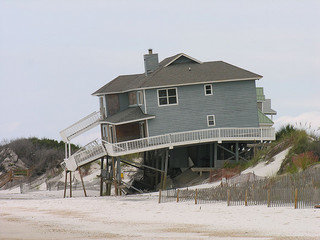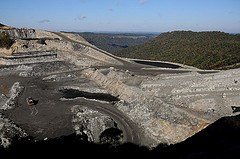Logic in the Face of Sea Level Rise
by Brent Blackwelder
 The response of federal and state governments to sea level rise leaves much to be desired. That’s because governments are stuck in a business-as-usual, grow-at-all-costs mindset. When the goal of the economy becomes sustainable and equitable well-being, rather than continuous growth, the response will be far more logical and ecologically sound.
The response of federal and state governments to sea level rise leaves much to be desired. That’s because governments are stuck in a business-as-usual, grow-at-all-costs mindset. When the goal of the economy becomes sustainable and equitable well-being, rather than continuous growth, the response will be far more logical and ecologically sound.
The need to address sea level rise is growing more urgent by the day. The Federal Emergency Management Agency (FEMA) estimates that 40 percent of the U.S. population lives in counties that border an ocean or a Great Lake — that’s 120 million people in the U.S. alone who are facing increased risks to their health and property.
Congress created an atrocious model for responding to coastal disasters when it passed the Hurricane Sandy relief measure in 2013. This model conflicts with the beneficial changes Congress had made to fix the bankrupt National Flood Insurance Program (NFIP), which remains $24 billion in the red. This year over 100 Members of Congress are prepared to gut the reforms with a 4-year delay because premiums are going to be too high. J. Robert Hunter, Administrator of the NFIP from 1974 to 1979, aptly characterized the NFIP debacle in a scathing letter to the Senate this January:
Consumers are not well served when the government runs an “insurance” program that is not true insurance, but rather, as the NFIP had become, an unwise and untargeted subsidy program that misleads consumers into putting their homes, businesses, and lives at risk in areas that are dangerously flood-prone and that often unfairly subsidize affluent individuals and contractors who do this building.
True-cost premiums would send a signal of the real and growing risk of building in hazardous coastal zones. Current political and economic practices, however, disguise the true costs and underwrite additional ill-advised construction in the coastal zone.
The U.S. government’s approach to sea level rise is the same as its misguided approach to inland flooding along rivers and streams that began in the early twentieth century: provide loans, grants, and subsidized insurance to build right back in flood-prone areas. Only occasionally has relocation been chosen.
The shocking result, delivered to President Lyndon Johnson by the 1966 Task Force on Federal Flood Control Policy, was that the more federal money spent on river engineering and flood control, the worse the flood damages became. The U.S. is headed for the same debacle with the bailout of coastal properties. The likely result is bankruptcy, given the large rise in sea level expected this century.

Construction on the coast produces a predictable outcome (photo by Judy Baxter).
If the government could get its economic act together by striving for a steady state rather than the impossibility of perpetual growth, it would take an entirely different approach. Subsidies for buildings in floodplains or along beaches would be eliminated. When inland or coastal flooding destroys structures in these zones, the steady-state response would be to relocate to higher ground away from the shoreline. This approach would not break the bank, but would provide resiliency not only for floodplains and beaches, but also for families and businesses.
Left in their natural condition, floodplains and beaches provide extraordinary benefits in the form of recreation, fish and wildlife habitat, flood control, and spiritual refreshment. Over the last century the massive shoreline build-out has put trillions of dollars at risk while simultaneously degrading the beauty of beaches and destroying natural storm barriers, such as mangrove forests.
There is strong evidence that mangrove forests help protect shorelines against storm surges. Despite the evidence, the World Bank continues to push projects like the Inga 3 hydro-complex that will harm downstream mangroves along the west coast of Africa.
Questions always arise over places like Lower Manhattan which has billions of dollars of buildings. Wealthy businesses and individuals could pay a lot to armor plate this urban zone for a while; however, using this strategy up and down the U.S. coastlines would be way too expensive.
Relocating people, especially in the wake of a disaster, is a difficult thing to do. But what is more humane? Finding a different but safe home for families or setting them up over and over again directly in the path of catastrophe? A true-cost economy would provide a much kinder response by assisting victims of weather disasters and avoiding the repetition of past mistakes.
We would do well to remember that 2,000 years ago Jesus used the analogy of the wise man building his house on the rock and the foolish man erecting his house on the sand. This parable is powerful because the listeners immediately recognized the folly of building on the beach.







The main problem associated with building in flood plains ie flooding could be solved by designing houses to be restorable after floods whilst also maintaining life support systems during them .
Timber frame buildings are useless for such a purpose since the timber would rot before it had dried out whilst retaining dried out residue.
Ground floor walls should be of solid lightweight closed cell insulating blocks clad also with removable waterproof insulation panels ,internal walls should be tiled and jetwashable.
In view of increasing longevity the old will by default live on ground floors with their younger generations living upstairs ,it is pointless to build houses on stilts for a once in fifty year flood
if electrics were built in above the plimsol line then power would not be cut in the event of a flood an extra mini kitchenette could be built into the the second and third generation loft living area ,the old could temporarily move upstairs .
With the development of combined heat and power generation from piped natural gas unaffected by flooding,it might also be possible due to the permanent on site electric supply to seal the house to 99% level and have a bilge pump permanently running during flooding, sewage tanks with non return valves could be a temporary store for human waste .
Hither to developers were reluctant to openly indicate risks of flooding by incorporating sensible measures within the structure aided and abetted by governments/other insurance payers subsidizing insurance in flood plains .
Adaptation to the environment now means insurance cover.